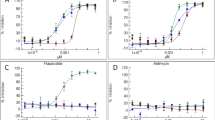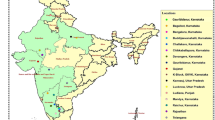Abstract
Rumple is a serious peel collapse of Primofiori lemons in the southeast of Spain with an unresolved aetiology. Symptoms typically occur on fruits at ripening under wet conditions as dark sunken lesions producing premature fruit drop and damaged fruits unacceptable for fresh commercialization. A total of 16 Colletotrichum spp. isolates established from rumple-affected lemons collected during the autumn of 2007 from two different orchards were characterized by molecular and phenotypic assays and compared with reference isolates. Species-specific PCR reactions using β-tubulin 2 nucleotide sequences showed Colletotrichum gloeosporioides to predominate (81.5%) with limited occurrence of C. acutatum (18.75%). Among the C. gloeosporioides isolates, five (38.5%) showed benomyl resistance and eight (61.5%) were highly sensitive to the fungicide. The limited occurrence of C. acutatum could be related to factors such as the presence of both species on the same fruit, unfavourable meteorological conditions and low disease incidence. This work reveals an association of C. gloeosporioides and C. acutatum isolates with rumple disease of lemons and expands the range of C. acutatum on citrus.

Similar content being viewed by others
References
Adaskaveg, J. E., & Hartin, R. J. (1997). Characterization of Colletotrichum acutatum isolates causing anthracnose of almond and peach in California. Phytopathology, 87, 979–987.
Alarcón, A. L., Madrid, R., & Egea, C. (1996). El rumple del limón: descripción y factores influyentes. Levante Agrícola, 337, 356–364.
Beltrán, C., Lucas, A., Hermosilla, A., Fernández, A., Martínez, F. J., & Romero, S. (2004). El colapso de la corteza del limón (rumple) en la Región de Murcia, ensayo de inoculación de hongos. Murcia 2002. Levante Agrícola, 370, 171–177.
Benyahia, H., Jrifi, A., Smaili, C., Afellah, M. & Timmer, L.W. (2003). First report of Colletotrichum gloeosporioides causing withertip on twigs and tear stain on fruit of citrus in Morocco. New Disease Reports, 7. Retrieved July 3, 2009, from http://www.bspp.org.uk/publications/new-disease-reports/ndr/php?id=007020
Brown, A. E., Sreenivasaprasad, S., & Timmer, L. W. (1996). Molecular characterization of show-growing orange and Key lime anthracnose strains of Colletotrichum from citrus as C. acutatum. Phytopathology, 86(5), 523–527.
Davino, M., Caruso, A., D’Urso, F., Marino, R., Terranova, G., & Starrantino, A. (1996). dsRNA analysis of Adamo lemon affected by ‘rumple’ disorder. Abstracts VIII Congress of the International Society of Citriculture, South Africa, pp. 23.
Del Rivero, J. M. (1967). El ‘rumple’ de los limones. Levante Agrícola, Noviembre, pp. 17.
Del Rivero, J. M. (1997). Rumple una alteración de la corteza de los limones. Agrícola Vergel, 184, 187–194.
Knorr, L. C. (1963). Rumple—a new disease of lemon fruit. Plant Disease Reporter, 47(5), 335–339.
Knorr, L. C., & Koo, R. C. J. (1969). Rumple—a serious rind collapse of lemons in Florida and Mediterranean countries. Proceedings First International Citrus Symposium, 3, 1463–1472.
Kuramae-Izioka, E. E., Lopes, C. R., Souza, N. L., & Machado, M. A. (1997). Morphologycal and molecular characterization of Colletotrichum spp. from citrus orchards affected by postbloom fruit drop in Brazil. European Journal of Plant Patholology, 103, 323–329.
Lucas, A. (1999). Incidencia de las plagas y enfermedades en la Región de Murcia. Phytoma España, 107, 44–54.
Majorana, G., & Continella, G. (1982). Rumple of lemon fruits an infectious-type disease. Tecnica Agricola, 34, 109–119.
Majorana, G., & Continella, G. (1983). Trasmissione di sintomi di ‘raggrinzimento della buccia’ a cloni nucellari di limone. Tecnica Agricola, 35(2), 143–151.
Martín, M. P., & García-Figueres, F. (1999). Colletotrichum acutatum and C. gloeosporioides cause anthracnose on olives. European Journal of Plant Pathology, 105, 733–741.
Martín, M. P., García-Figueres, F., & Trapero, A. (2002). Iniciadores específicos para detectar las especies de Colletotrichum causantes de la antracnosis de los olivos. Boletín de Sanidad Vegetal Plagas, 28, 43–50.
Ozbek, N., Ozsan, M., Tuzcu, O., & Danisman, S. (1976). A preliminary study of rumple a serious rind disorder of lemons in Turkey. Proceedings Seventh Conference of the International Organization of Citrus Virologists, Riverside, 157–166.
Peres, N. A., Souza, N. L., Peever, T. L., & Timmer, L. W. (2004). Benomyl sensitivity of isolates of Colletotrichum acutatum and C. gloeosporioides from citrus. Plant Disease, 88, 125–130.
Peres, N. A., MacKenzie, S. J., Peever, T. L., & Timmer, L. W. (2008). Postbloom fruit drop of citrus and Key lime anthracnose are caused by distinct phylogenetic lineages of Colletotrichum acutatum. Phytopathology, 98(3), 345–352.
Pinilla, M. P. (1991). ‘Viruela o corteza arrugada’ en frutos de limonero. CRIA, La Alberca, Murcia, 31 pp.
Russo, F., & Klotz, L. J. (1963). Wrinkle rind of lemons in Italy. California Citrograph, 48, 264.
Salerno, M. (1963). Il ‘raggrinzimento della buccia’ grave alterazione dei frutti di limone. Tecnica Agricola, 15, 507–511.
Talhinhas, P., Sreenivasaprasad, S., Neves-Martins, J., & Oliveira, H. (2002). Genetic and morphological characterisation of Colletotrichum acutatum causing anthracnose of lupins. Phytopathology, 92, 986–996.
Talhinhas, P., Sreenivasaprasad, S., Neves-Martins, J., & Oliveira, H. (2005). Molecular and phenotypic analyses reveal association of diverse Colletotrichum acutatum groups and a low level of C. gloeosporioides with olive anthracnose. Applied and Environmental Microbiology, 71(6), 2987–2998.
Timmer, L. W., Garnsey, S. M., & Graham, J. H. (Eds.). (2000). Compendium of citrus diseases (2nd ed.). St. Paul: APS.
Valero, M., Fernández, P. S., & Salmerón, M. C. (1999). El arrugamiento de la corteza del limón o rumple, una enfermedad de origen fúngico. Phytoma España, 110, 26–34.
Whiteside, J. O. (1988a). Rumple of lemons. In J. O. Whiteside, S. M. Garnsey, & L. W. Timmer (Eds.), Compendium of citrus diseases (p. 67). St. Paul: APS.
Whiteside, J. O. (1988b). Anthracnose. In J. O. Whiteside, S. M. Garnsey, & L. W. Timmer (Eds.), Compendium of citrus diseases (pp. 9–10). St. Paul: APS.
Zulfiqar, M., Brlansky, R. H., & Timmer, L. W. (1996). Infection of flower and vegetative tissues of citrus by Colletotrichum acutatum and C. gloeosporioides. Mycologia, 88(1), 121–128.
Acknowledgements
This study was financed by the Programa de Desarrollo y Diversificación Económica de Zonas Rurales (PRODER) through the Grupo de Acción Local Vega Baja Desarrollo Rural (VEBADER), Expedient 7.4.060. The authors are grateful to Enrique Galbis Biosca from FITOGAL, S.L for the supply of fungicide.
Author information
Authors and Affiliations
Corresponding author
Rights and permissions
About this article
Cite this article
Valero, M., García-Martínez, S., Giner, M.J. et al. Benomyl sensitivity assays and species-specific PCR reactions highlight association of two Colletotrichum gloeosporioides types and C. acutatum with rumple disease on Primofiori lemons. Eur J Plant Pathol 127, 399–405 (2010). https://doi.org/10.1007/s10658-010-9606-0
Accepted:
Published:
Issue Date:
DOI: https://doi.org/10.1007/s10658-010-9606-0




